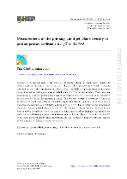Measurement of the primary Lund jet plane density in proton-proton collisions at √s=13 TeV

Autor
Hayrapetyan, A.
Tumasyan, A.
Adam, W.
Andrejkovic, J. W.
Bergauer, T.
Chatterjee, S.
Damanakis, K.
Dragicevic, M.
Del Valle, A. Escalante
Hussain, P. S.
Datum vydání
2024Publikováno v
Journal of High Energy PhysicsRočník / Číslo vydání
neuveden (5)ISBN / ISSN
ISSN: 1029-8479Metadata
Zobrazit celý záznamKolekce
Tato publikace má vydavatelskou verzi s DOI 10.1007/JHEP05(2024)116
Abstrakt
A measurement is presented of the primary Lund jet plane (LJP) density in inclusive jet production in proton-proton collisions. The analysis uses 138 fb(-1) of data collected by the CMS experiment at root s = 13TeV. The LJP, a representation of the phase space of emissions inside jets, is constructed using iterative jet declustering. The transverse momentum kT and the splitting angle Delta R of an emission relative to its emitter are measured at each step of the jet declustering process. The average density of emissions as function of ln( k(T)/GeV) and ln( R/Delta R) is measured for jets with distance parameters R = 0.4 or 0.8, transverse momentum p(T) > 700 GeV, and rapidity |y| < 1.7. The jet substructure is measured using the charged-particle tracks of the jet. The measured distributions, unfolded to the level of stable charged particles, are compared with theoretical predictions from simulations and with perturbative quantum chromodynamics calculations. Due to the ability of the LJP to factorize physical effects, these measurements can be used to improve different aspects of the physics modeling in event generators.
Klíčová slova
Hadron-Hadron Scattering, Jet Substructure and Boosted Jets, Jets,
Trvalý odkaz
https://hdl.handle.net/20.500.14178/3008Licence
Licence pro užití plného textu výsledku: Creative Commons Uveďte původ 4.0 International






